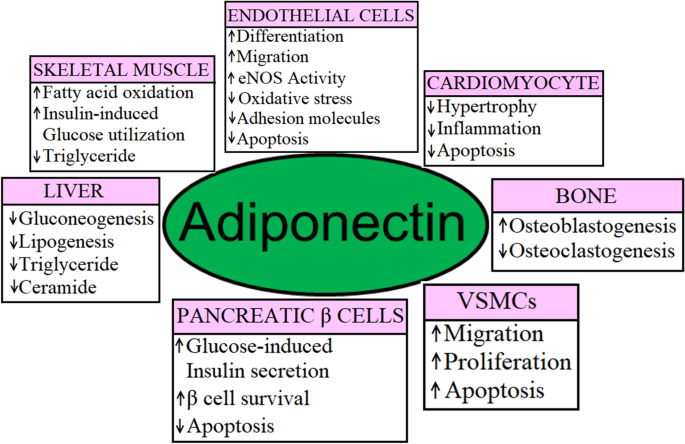Adiponectin/ adipokine is a protein hormone, which is involved in the regulation of glucose levels, as well as in the breakdown of fatty acids. In humans it is encoded by the ADIPOQ gene and is produced mainly in adipose tissue, but also in muscle and even in the brain.
Adiponectin function
Adiponectin is a protein hormone that modulates a number of metabolic processes, including glucose regulation and fatty acid oxidation. Adiponectin is secreted by adipose tissue (and also by the placenta during pregnancy) into the blood and is highly abundant relative to many hormones. Many studies have found that adiponectin is inversely correlated with body mass index in various patients. However, a meta-analysis failed to confirm this association in healthy adults.
Circulating adiponectin concentrations increase during caloric restriction in animals and in humans, such as in patients with anorexia nervosa. This observation is surprising given that adiponectin is produced by adipose tissue. However, a recent study suggests that bone marrow adipose tissue, which increases during caloric restriction, contributes to the increase in circulating adiponectin in this setting.
Transgenic mice with increased adiponectin show reduced adipocyte differentiation and increased energy expenditure associated with mitochondrial uncoupling. The hormone plays a role in suppressing metabolic disorders that can lead to type 2 diabetes, obesity, atherosclerosis, non-alcoholic fatty liver disease (NAFLD) and an independent risk factor for metabolic syndrome. Adiponectin in combination with leptin has been shown to completely reverse insulin resistance in mice.
Adiponectin exerts some of its weight-reducing effects through the brain. This is similar to the action of leptin; adiponectin and leptin may act synergistically.
Adiponectin promotes synaptic and memory function in the brain. People with lower adiponectin levels have reduced cognitive function.
Effects of adiponectin:
-glucose flux:
1.decreased gluconeogenesis
2.increased glucose uptake [8] [20] [31]
– lipid catabolism:
1.β-oxidation [20]
2.triglyceride clearance [20]
-protection against endothelial dysfunction (important facet of atherosclerotic formation)
-sensitivity to insulin
-weight loss
– control of energy metabolism:
-upregulation of uncoupling proteins
– reduction of TNF-alpha
– promoting the reverse transport of cholesterol
Regulation of adiponectin
Obesity is associated with decreased adiponectin.
The exact mechanism of regulation is unknown, but adiponectin could be regulated by post-translational mechanisms in cells.
Hypoadiponectinemia
A low level of adiponectin is an independent risk factor for the development of:
– Metabolic syndrome
-Diabetes
Human PubMed Reference:”. National Center for Biotechnology Information, U.S. National Library of Medicine
„Mouse PubMed Reference:”. National Center for Biotechnology Information, U.S. National Library of Medicine.
Martinez-Huenchullan SF, Tam CS, Ban LA, Ehrenfeld-Slater P, Mclennan SV, Twigg SM (2020). „Skeletal muscle adiponectin induction in obesity and exercise”. Metabolism: Clinical and Experimental. 102: 154008. doi:10.1016/j.metabol.2019.154008. PMID 31706980.
Cawthorn WP, Scheller EL, Learman BS, Parlee SD, Simon BR, Mori H, Ning X, Bree AJ, Schell B, Broome DT, Soliman SS, DelProposto JL, Lumeng CN, Mitra A, Pandit SV, Gallagher KA, Miller JD, Krishnan V, Hui SK, Bredella MA, Fazeli PK, Klibanski A, Horowitz MC, Rosen CJ, MacDougald OA (August 2014). „Bone marrow adipose tissue is an endocrine organ that contributes to increased circulating adiponectin during caloric restriction”. Cell Metabolism. 20 (2): 368–75. doi:10.1016/j.cmet.2014.06.003. PMC 4126847. PMID 24998914.
Fang X, Sweeney G (November 2006). „Mechanisms regulating energy metabolism by adiponectin in obesity and diabetes”. Biochemical Society Transactions. 34 (Pt 5): 798–801. doi:10.1042/BST0340798. PMID 17052201. S2CID 1473301.


